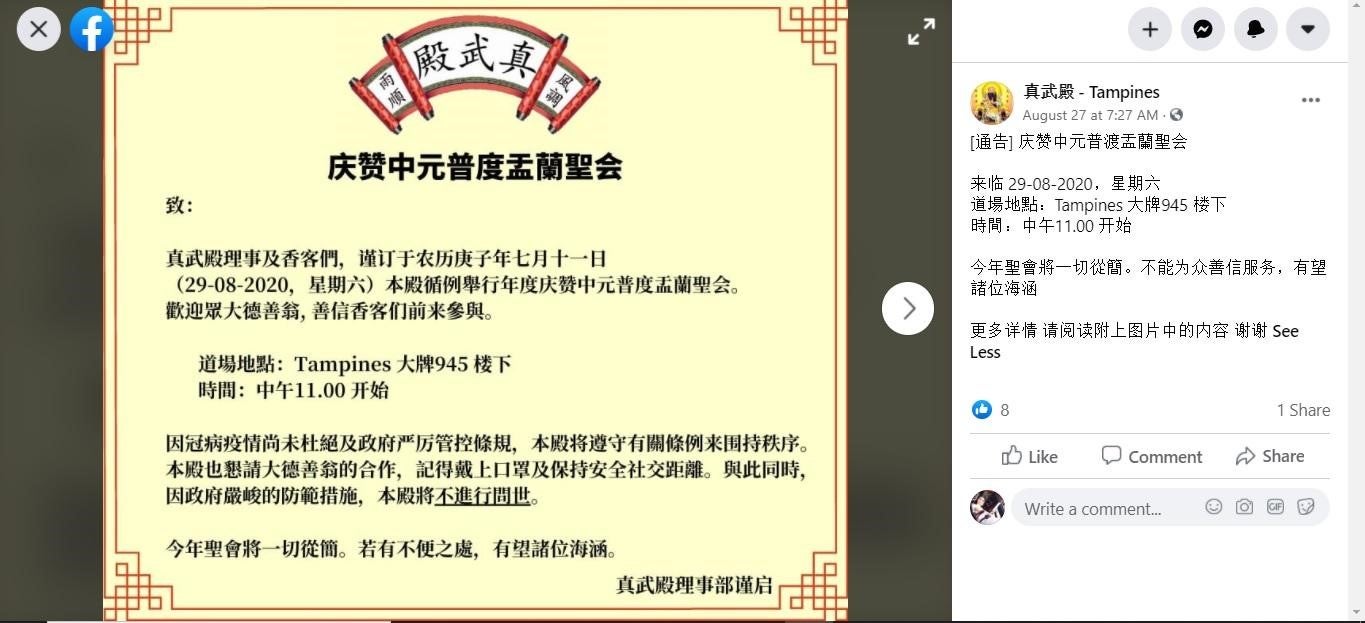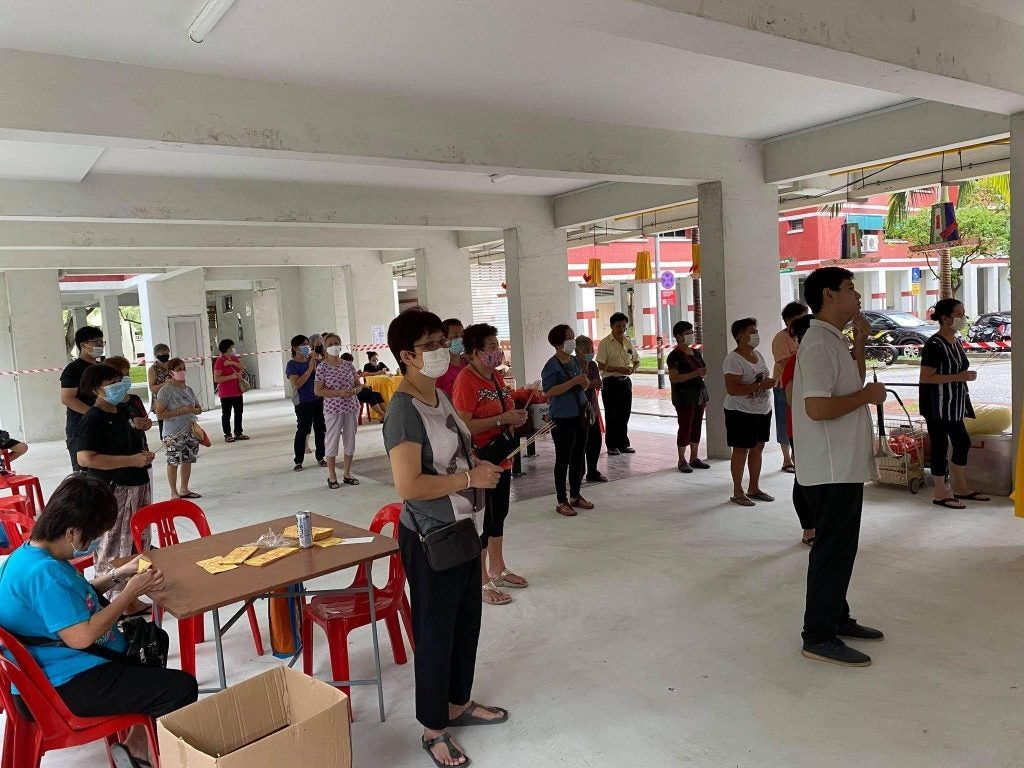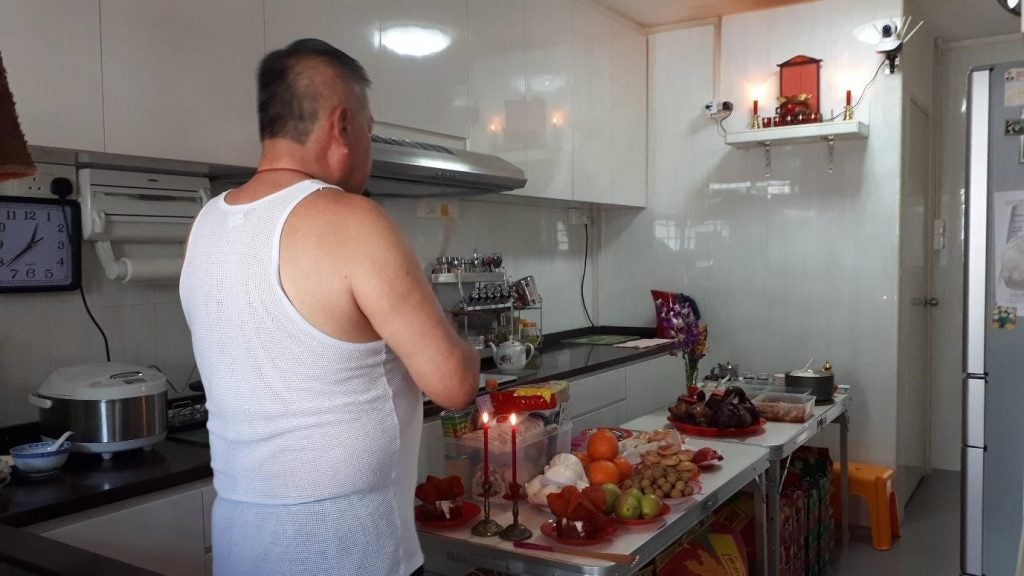Prayers, Protocols and Pandemics, Part 2: Crowdsourcing without Crowds and the ‘New Normal’ of Religious Ethnography in Singapore after the Seventh Month Festivities
contributed by Soh Chuah Meng Esmond, 18 September 2020
Previously, I have sketched out the broad contours of how popular interpretations and outlooks held by Singaporeans of the seventh lunar month have fed into, and also informed concerns and worldviews associated with the second phase of Singapore’s re-opening from the Circuit Breaker (CB) in June. Here, I am shifting my attention to the practical dimensions of Chinese religious practice. How do sentiments and attitudes towards these precautionary measures feed into this-worldly activities? Drawing upon crowd-sourced photographs in Singapore throughout the first-half of the seventh lunar month of the year, I broadly mark some of the key transitions that have occurred, as well as what these trends bode for upcoming Chinese festivals in 2020.
Some aspects of practice associated with the seventh month have continued unabated. With or without communal celebrations at a large scale, the scent of smouldering joss paper marking the beginning, middle and end of the seventh month continues to feature dominantly.
Yet other aspects of observing the seventh lunar month, such as auctions – accompanied by communal banquets – that serve to raise funds for the next year’s celebrations have shrunk, if not scraped totally this year. Large tentages in the late-2010s have given way to more modest set-ups prepared to feast and entertain both the dearly-departed and a crowd of wandering spirits (Figures 1 and 2, in contrast to Figure 3). Getais associated with Hokkien and Cantopop musicals hosted to please and entertain the spirits around the island have also taken to cyberspace as a result.

Figure 1. Source: Sunny Lim, “Kovan Market 7th Lunar Month Celebration,” Facebook, September 18, 2017. https://www.facebook.com/photo?fbid=10155134252711748&set=a.10155134247651748. Photograph courtesy of Sunny Lim

Figure 2. Source: Sunny Lim, “Kovan Market 7th Lunar Month Celebration,” Facebook photo, September 18, 2017. https://www.facebook.com/photo?fbid=10155134248641748&set=a.10155134247651748. Photograph courtesy of Sunny Lim

Figure 3. Source: Sunny Lim, “Kovan Market,” in “7th Month Festival Singapore,” Facebook photo, August 30, 2020. https://www.facebook.com/photo?fbid=10157829705016748&set=pcb.1887462451394634. Note the smaller tentage and ritual space, as well as the one metre distance maintained behind devotees during the ceremony. Photograph courtesy of Sunny Lim
Restrictions upon the number of participants vis-à-vis the scale of ritual spaces do pose a handicap to many smaller and communal places of worship, where the worth of renao (literally: “hot and noisy”) during these celebrations cannot be underestimated in generating a short-lived communitas between participants. Covid-19 had exacerbated the financial situation of smaller religious institutions which live on a hand-to-mouth basis, and the deprivation of donations associated with these “short concentrated bursts” of ritual activity could potentially push them off the edge. This, as Yue had pointed out, had hit ancillary businesses involved in the trade of related goods and services just as badly.

Figure 4. Source: 真武殿 – Tampines, “[通告] 庆赞中元普渡,” Facebook photo, 27 August 2020. https://www.facebook.com/zhenwudian945/photos/a.227492937598108/1263138970700161/. Note the statement on how all participating devotees are required to not only wear a mask, but enforce strict safe distancing measures as well. Similarly, spirit-medium sessions are halted as a result of this temple’s adherence to regulatory guidelines
Online notices informed devotees of the stance that individual temples have taken in response to these measures (Figure 4). While some have chosen to err on the side of safety by suspending all activities related to the seventh lunar month festivities until the worst of Covid-19 has passed, other temples have chosen to hold their seventh month festivities after taking necessary precautions. For example, on the eleventh day of the seventh lunar month, Shicheng Ba Hai Gong’s worship service took place, but with the enforcement of safe distancing measures between attending devotees and religious specialists (Figures 5 and 6).

Figure 5. Source: Shicheng Ba Hai Gong, “獅城八海宮 || 庚子年七月初十一日 @ 29th August 2020,” Facebook photo, August 29, 2020, https://www.facebook.com/photo/?fbid=744926982757289&set=a.744930046090316. Note the practice of safe distancing between individual devotees. Photograph courtesy of Shicheng Ba Hai Gong, Singapore

Figure 6. Source: Shicheng Ba Hai Gong, “獅城八海宮 || 庚子年七月初十一日 @ 29th August 2020,” Facebook photo, August 29, 2020, https://www.facebook.com/photo/?fbid=744926982757289&set=a.744930046090316. Note the practice of safe distancing between individual devotees. Photograph courtesy of Shicheng Ba Hai Gong, Singapore
The case of Tian Ci Gong in the Punggol Combined Temple is equally instructive, where both the needs of devotees and safe distancing measures managed to find a middleground. On the first night, it was the temple’s leadership and religious specialist who consecrated the temporary ritual space which will host the spirits who will wander the earth for the month. The public was only allowed to present their respects at the makeshift altar from the next day onwards. In here a concession has been brokered: although key events were restricted to a select few, the temple’s devotees (including myself) were welcome – after checking in and having their temperatures taken – in a stream over the same month. As Koh had noted earlier, Chinese religious organisations and their rituals have demonstrated much manoeuvrability and readiness to negotiate with the needs of their time, and we can expect to see similar practices as the rest of the seventh month unfolds.
The resilience of Chinese religious institutions, practices and rituals, as Koh notes elsewhere, should not be underestimated. While the downsizing of such ceremonies is a part of the ‘new normal’ highlighting the second phase of Singapore’s reopening after the circuit breaker period, it should be stressed that for smaller organisations who worship on a private, rather than communal basis, the fallout of phase two’s restrictions are less severe than previously understood. Being small to begin with – and thus unlikely to involve participants from beyond the confines of a single shop or business – such makeshift altars can be found throughout Singapore (Figures 7, 8 and 9). Nevertheless, their numbers and size had shrunk. Some– such as the coffee shop adjacent to my home – have chosen to dispense with makeshift altars this year, given that it used to be positioned at a chokepoint that overlaps with elongated queuing markers from the neighbouring minimart.

Figure 7. Source: Victor Yue, “[7th Month Festival] 华声音乐社 H.S.M.A. has its 7th Month prayer today (30-Aug-20),” in “7th Month Festival Singapore,” Facebook photo, August 30, 2020, https://www.facebook.com/groups/7thMonth/?post_id=1887867848020761. Photograph courtesy of Victor Yue

Figure 8. Source: Sung Chang Da, “Tradehub 21, Boon Lay,” in “7th Month Festival Singapore,” Facebook photo, August 29, 2020, https://www.facebook.com/groups/7thMonth?post_id=1886153674858845. The smaller altar to the left is left for the spirits of children who are smaller in height. Photograph courtesy of Sung Chang Da

Figure 9. Source: Ngee Goh, “7th Month Festival 2020,” Facebook photo, August 31, 2020, https://www.facebook.com/photo/?fbid=3743286802367261&set=a.3743276805701594. Photograph courtesy of Ngee Goh of Chan Ngee
On the other hand, questions about the heterogeneity of land-, smell- and soundscapes associated with the seventh month festivities remain relatively understudied in Singapore’s context, despite the island’s geographical compactness. Advisories and regulations pertaining to the resumption of religious activities in phase two, while universal, have affected different neighbourhoods and estates disproportionately. Some of the most beautiful temporary tentage and altars erected to observe the seventh month festivities around Singapore are nestled within mature neighbourhoods – Queenstown, Tiong Bahru, Toa Payoh and the Chinatown areas.

Figure 10. Source: The author, “Ancestor worship at the Soh Family, Woodlands, Singapore” 30 August 2020. My uncle is shown offering the first three sticks of incense to my ancestors on the extended family’s behalf in this photograph. Note the ‘goody bags’ under the table
The potential fallout on these communities where the seventh lunar month holds a pride of place as an opportunity for like-minded devotees to gather should not be underestimated. Given that most of the organisers and participants in these collective worship ceremonies have been historically affiliated with the locality, the scaling-down of these events – alongside limitations on the size of participants at any one in time – and ongoing efforts taken to reduce contact between groups and individuals could serve to dampen sentiments of communitas that were built across the years. Precautions like these, of course, are not only confined to communal observations, but extend to senior citizens who have socially isolated themselves as well. For example, given that a single home can only host five visitors with the advent of Singapore’s second phase of re-opening, one of my elderly paternal aunts (who I see only during family religious rituals) had absented herself from the most recent ceremony observed at my paternal uncle’s home (Figure 10).

Figure 11. Source: Sung Chang Da, “Henderson Road,” in “7th Month Festival Singapore,” Facebook photo, August 30, 2020, https://www.facebook.com/groups/7thMonth?post_id=1887904358017110. The full details of the red banner pasted onto the left of the makeshift altar describe how the “residents and hawkers in the Redhill area” have sponsored this event in 2020. Photograph courtesy of Sung Chang Da
In contrast, in the newer housing estates in north-east Singapore – where I am living in currently – communal altars and associations devoted to the worship of the “good brothers” (a local expression for wandering spirits) (Figure 11) remain absent. Earlier observations about how the heartlands have hosted unofficial “spiritual spaces (that) are reified through the use of transient aesthetic markers in the form of itinerant altars,” while valid, are not evenly distributed across the island. That is not to say that the occasion is not observed in newer neighbourhoods. My neighbours on the tenth floor have carted joss papers and prayer paraphernalia from their homes to burning bins in the same carts that they use for grocery shopping.
Yet, one feature stands out: most devotees are senior citizens, and few of them in my estate – to the best of my knowledge – are engaged in the worship of the “good brothers” with younger family members. Rulings that limit the number of congregants for communal celebrations related to the seventh lunar month, while applied across the board in Singapore, are spatially-uneven in their effects. Younger estates like Punggol – which do not have a legacy of such traditions to begin with – continued life with minimal effect, whereas older neighbourhoods are deprived of an annual opportunity to get together.

Figure 12. Source: 神仙宫, “通告,” Facebook pinned post [Chinese part only], August 26, 2020. In English: “ Notice: Due to Covid-19 pandemic, SHIN SEN KENG TEMPLE will not be holding the annual Yearly Kiu Ong Yah Festival as per normal. After the Committee Board Discussion, SHIN SEN KENG TEMPLE will only hold a Minor Praying Ceremony "Prayers As Usual". Full post with English translation can be viewed at this URL https://www.facebook.com/ShinSenKeng/posts/1699741136858176
Concluding this discussion on the seventh month, one is tempted to look into the future, and by extension, Covid-19’s impact on similar events. The Mid-Autumn Festival observed on the fifteenth day of the eighth lunar month, as of the end of August, looks set to move online as well. The fifteenth day of the seventh month, while typically associated with the apex of the festivities, is concurrently a key marker for the upcoming Festival of the Nine Emperor Gods in the ninth lunar month (held in October 2020), where especially-devout adherents will begin their 49-day vegetarian diet in anticipation of the event. Similarly, while the author is looking forward to connecting with his friends and fellow devotees in a Nine Emperor Gods temple in Johor Bahru as he did in 2019, it seems that these plans would have to be scraped given that the Recovery Phase of the Movement Control Order (RMCO) in Malaysia has been extended until the end of 2020. Likewise, by end August 2020, one of the oldest Nine Emperor Gods temples in Singapore have officially announced the scaling-down of its religious activities for the eponymous event in 2020 (Figure 12). Thus far, hopes for Covid-19 to cease its rampage across Singapore – if not the globe – do not look set to come true in the coming weeks. Only time will tell.
Disclaimer: The views and opinions expressed in this article are those of the authors and do not necessarily reflect the position of the blog editorial team or the Asia Research Institute.
South Asia | Southeast Asia | East Asia | Other Places | Hinduism | Buddhism | Islam | Christianity | Other Religions
Soh Chuah Meng Esmond is a History graduate student enrolled in the Master of Arts program at the Nanyang Technological University, School of Humanities (SoH), Singapore. His research interests include the history of religion, diasporic Chinese religion and the history of the overseas Chinese in Southeast Asia.

